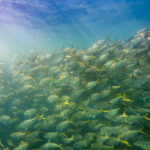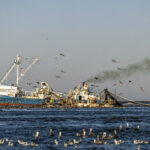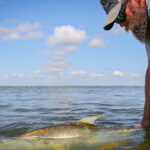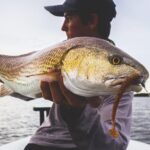
Take The Cut: Massive Reductions for Menhaden Industry Necessary
What’s going on? The “most important fish in the sea” just exposed one of the
Feature Photo Credit: Adam Eaton
Summer doldrums may be here for many, while others are cursing the Northeast wind machine, but reports of bait setting up and hard tails filtering in should get everyone excited for the Fall Run. Next week, the ASGA team will be tuned into the ASMFC Summer Meeting. Each quarterly ASMFC Meeting has important agenda items, and some meetings more than others. This go-around the various ASMFC Boards will receive a slate of updates, with not much in the form of formal decision making. As far as striped bass go, all eyes remain on the Fall Meeting and the release of the 2024 Stock Assessment. Keep reading for what we might learn about striped bass and other species’ management next week:
Striped Bass: Tuesday, August 6th, 1pm
Striped bass fishing in 2024 has had its moments of grander, but the coast is starting to realize the stock is in trouble: the stock remains overfished, rebuilding is a huge question mark, we are going on five consecutive failed spawns in the Chesapeake Bay, and it remains to be seen if recruitment improved this year. Just about every striped bass stakeholder awaits the results of the 2024 stock assessment and Maryland’s young of the year survey—scheduled for release this October—including striped bass managers.
The Striped Bass Recreational Release Mortality Working Group, which was established at the Spring 2024 Meeting and includes managers and state fishery agency staff, met several times over the past few months. The objectives of this working group were to review existing no-targeting closures, review the MA DMF release mortality study (to consider potential gear modifications), identify specific stock assessment sensitivity runs (to explore the impact of lowering releases), consider public scoping, and provide a report to the Board. We paid close attention to these meetings and remain cautiously optimistic that the Board will consider science-based alternatives to lower the impact of recreational release mortality without sweeping no-targeting closures.

As you all know, ASGA has followed the Mass DMF release mortality study’s progress very closely and worked to expand the sample size with our GotOne partnership. Well, we went a step further to operationalize the study’s initial findings and ensure safer fishing techniques with the release of The Local Singles Campaign. The voluntary program encourages anglers to make gear choices that give released striped bass the best chance for survival. In recent weeks participation has taken off and we are thrilled to be announcing additional participating tackle shops and manufacturers in the coming weeks.
The Striped Bass Board will receive updates from that work group, which from our perspective will be the most important discussion of the day, if not the whole meeting. We now know how to lower release mortality with the MA DMF study—The Board must consider these science-based alternatives, should the 2024 Stock Assessment warrant a reduction.
UPDATE – AUGUST 02, 2024: Top-line messages from the RRM Working Group Reports:
In addition, the Board will receive the 2023 FMP review—which will show the efficacy of the new slot limit and fishing effort last year, among other things—and get a progress report/timeline update on the 2024 stock assessment. The Board may provide important input on the stock assessment and potential responses, so this is still a very important session to pay attention to.
Cobia: Wednesday, August 7th , 1:30pm
The Coastal Pelagics Board will take final action on Atlantic Cobia Addendum II. The primary goal of this action is to revise how recreational cobia allocations are distributed and other tweaks to improve how this shifting species is managed. ASGA commented on this action, which you can read HERE.
In short, ASGA advocated for a coastwide recreational allocation and harvest target. This allocation scheme makes the most sense for a species like cobia, which are shifting/expanding their range AND are a terribly difficult species for recreational fishing surveys (MRIP) to effectively capture. We were somewhat discouraged that this action did not seek opportunities to improve recreational cobia data quality or accuracy, however.
This Board will also receive an update form the South Atlantic Fishery Management Council on Mackerel Port meetings, which were held over the past several months. This is another example of managers seeking to address management challenges with shifting or expanding species.
Menhaden: Tuesday, August 6th, 10am
Menhaden are an undisputed critical forage fish that support so many incredible fisheries and marine ecosystems, but its management is often more controversial and, frankly, frustrating. While there are no immediate management decisions on the Menhaden agenda, there will be important discussions about the progress of the single species and Ecological Reference Point Stock Assessments slated for 2025 as well as a presentation from the USGS on Chesapeake Bay Osprey, which has been an important indicator within menhaden management discussions.
The agenda item we will be paying closest attention to is “Discuss Possible Chesapeake Bay Management.” We will provide updates to this agenda item, as supplemental materials are posted later this week.
Other Forage Fish:
Fisheries Data Modernization and Accuracy Act of 2024:
Both the ASMFC’s Executive Committee and Policy Board will discuss H.R. 8705, Fisheries Data Modernization and Accuracy Act of 2024, introduced by Congressman Garrett Graves (R-LA-06) in response to the ongoing challenges with MRIP. As a refresher, MRIP is the primary federal data collection source for recreational marine fisheries, and potential overestimation biases were discovered last summer. MRIP is undoubtedly flawed, and the recreational data collection enterprise is in dire need of innovation and improvement, but we fear this legislation would weaken federal recreational data activities (a supported, central data program is necessary for migratory fisheries that are not bound to lines of states’ jurisdictions), cherry-pick data streams, and potentially threaten the sustainability of recreational and commercially important fisheries. To summarize, ASGA believes MRIP is in dire need of a revamp to improve the accuracy and reliability of estimates—we are working with NOAA Fisheries as it continues its MRIP RE-Envisioning process—but we do not think this bill would achieve that but rather create a patchwork of un-reliable and disjointed surveys.
This blog has been updated since the supplemental meeting materials were posted. See blue update bar above. As always, ASGA will share a recap blog after the meeting, providing you all with updates on the important discussions and decisions. Be sure to reach out if you have any questions about this meeting via social media or by email at (info@saltwaterguidesassociation.org).

What’s going on? The “most important fish in the sea” just exposed one of the

Mario CampoFisheries Ecologist, Southeastern Louisiana UniversityScience and Policy Associate, American Saltwater Guides Association This discussion

The Jack Project continues to gather momentum as tagging teams across the Gulf and South

This guide is meant to educate anglers, conservationists, and the public about the Atlantic States
We rely on our members and donations to keep fighting for a sustainable tomorrow in marine conservation.
GIVE THE GIFT OF FISHERIES CONSERVATION THIS HOLIDAY SEASON. SHOP ASGA GOODS THAT FUND FISHERIES RESEARCH & ADVOCACY CAMPAIGNS
JOIN ASGA IN CALLING FOR CRITICAL MANAGEMENT ACTION AFTER YEARS OF SPAWN FAILURES & POOR MANAGEMENT.
By using this website, you agree to our use of cookies. We use cookies to provide you with a great experience and to help our website run effectively. To learn more, please review our privacy policy.